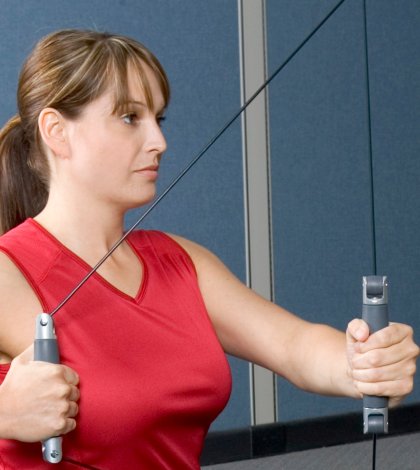Any serious strength and conditioning program understands that the development of strength is a complex and intricate process. Strength, however, comes in many different forms. Understanding the different types of strength allows both the athlete and the coach to create meaningful training programs that will help the athlete achieve the specific goals of his or her sport.
Types of Strength
1. Maximum Strength – The athlete’s voluntary strength potential. Roughly translated, how much can you lift on a given day barring any extreme conditions? For example, trying to find a new 1 RM (voluntary lifting) is much different than trying to lift a car that has your son or daughter pinned underneath it (involuntary lifting).
2. Speed-Strength – Think of throwing a small implement as fast and as far as you can. That is speed-strength. Speed-strength is your body’s ability to quickly perform a movement with low external resistance.
3. Strength-Speed – Weightlifting is a classic example of the demonstration of strength-speed. While speed does matter, strength is much more vital. Athletes must move maximal to submaximal loads with enough force and velocity to successfully complete a lift.
4. Starting Strength – How quickly can an athlete generate force on to an object at rest? Developing starting strength is especially important for powerlifters and weightlifters as they must quickly generate force as they begin a lift.
5. Acceleration Strength – Building off of starting strength, acceleration strength is an athlete’s ability to develop more force on an already moving object. Think of the second pull in either a clean or snatch. The barbell has broken from the ground and past the knees and must be accelerated quickly at the mid thigh prior to triple extension finish of the ankles, knees, and hips.
6. Strength-Endurance – For endurance athletes and CrossFitters, being able to maintain muscular functioning under conditions of extended duration are paramount. For CrossFitters who struggle with “chipper” style workouts, the lack of strength endurance is one of the main culprits.
(Verkoshansky, Yuri. (2009) Supertraining. Ultimate Athlete Concepts: USA (pp 107-108, 130).
How to Develop Different Types of Strength
Obviously, different sports place unique demands on their athletes. In relation to CrossFit, developing these different types of strength can be a daunting task.
Strength Endurance
Outside the realm of metabolic conditioning, strength endurance can be boosted via long work sets of a given lift with little recovery. For example:
A. Strict Overhead Press X0X1 tempo
15,15,15 Rest 1 minute.
Density sets would also be great way to add volume to the training program and subsequently exhaust the given muscle group. For an athlete who might be struggling with upper body push horizontal movements, the following prescription (and variations) twice a week would be suggested.
A1. 5 Strict Ring Dips 30X1 tempo. 20 seconds Rest.
A2. 5 Close Grip Bench Press 30X1 tempo. No Rest.
A3. 30 Hand Release Pushups Rest 30 seconds
A4. Max Effort Overhead Plate Extensions Rest 3 minutes.
4 sets.
Within the realm of metabolic conditioning, chipper style workouts would be an excellent choice. For example:
20 minute AMRAP
50 Overhead Walking Lunges (45/25)
50 Calories on the Airdyne
50 Pushups
50 Wall Balls (20/14)
Starting Strength
Moving any external object begins with a brief isometric contraction of the muscle as the force acting upon the object slowly overpowers the force of gravity. One of the first ways to develop starting strength is to teach the body how to recruit not only the primary muscles driving the movement, but also other auxiliary muscles supporting the movement. The more muscles recruited during a movement the more force can be generated to help move weight. Take the deadlift for instance. Before the lift occurs, the athlete should squeeze the bar in his or her hands and concurrently squeeze his or her feet, legs, butt, lats, arms… in short squeeze as many muscles as possible. He or she does not have to lift the bar yet. At this stage, the athlete is merely cultivating the ability to turn on the muscles which will be utilized during the lift.
Once these isometric contractions have been practiced, encourage the athlete to begin lifting the load. Now, to develop this type of strength the athlete does not need to take the implement to a full range of motion. An example of some lifts that can help develop this kind of strength.
Deadlifts/ Cleans / Snatches to below the knee.
Pause Jerk Drives
Half Squats from the Bottom of pins on the rack.
Heavier weights 85-95% of a one rep max are recommended for building starting strength. Given the shorter time under tension, lack of an eccentric contraction (lowering the weight), and/or shorter range of motion, the central nervous system is not stressed as much and therefore can handle more intense loading schemes.
Acceleration Strength
In weightlifting acceleration strength can be accomplished with snatches or cleans from the hang or with clean or snatch pulls from the ground. One drill that I use from time to time is forcing athletes into the hang position and then working them up to their hips with a slow ascent until they reach the power position. Once they reach that position they violently explode, accelerate the bar, and complete the lift. Another benefit to this is that they learn better bar positioning during the second pull which is incredibly important to successful lifting. Again, during this type of strength, the implement is already moving. We just have to teach the body to move that load faster.
Speed-Strength
Not a category of strength with which CrossFitters or weightlifters need to concern themselves, given the higher intensity of the loads they are required to lift.
Strength-Speed
While strength is more vital than speed here, learning how to create force is a key ingredient to successful strength-speed development. A periodized Olympic weightlifting program is an excellent example of developing strength-speed. (More on the Steelworks CrossFit Method in a future post.)
Depending on the sport of your choice, developing different types of strength are essential for optimal athletic performance. As you and your coach build a training program assess where you are the weakest and spend time addressing those weak points.
Happy lifting.
Brian Terpak

 Entertainment52 years ago
Entertainment52 years ago
 Articles52 years ago
Articles52 years ago
 Fitness & Sports52 years ago
Fitness & Sports52 years ago
 Entertainment52 years ago
Entertainment52 years ago
 Beauty52 years ago
Beauty52 years ago
 Fitness & Sports52 years ago
Fitness & Sports52 years ago
 Travel52 years ago
Travel52 years ago
 Food52 years ago
Food52 years ago













